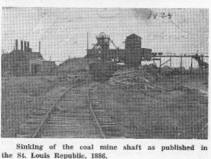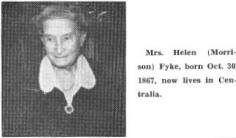
ODIN COAL MINEODIN OVERJOYED GRAND DEMONSTRATION BY PEOPLE OF TOWN AND COUNTRY ALL ON ACCOUNT OF THE SUCCESSFUL SEARCH FOR COAL COMPLETE HISTORY OF THE INCEPTION AND PROGRESS OF THE ENTERPRISE MEN WHO PUSHED THE PROJECT THROUGH WHO THEY ARE AND HOW THEY LOOK Odin, Ill., June 22—(Correspondence).
Tomorrow will be heralded by the citizens of this place as the awakening of a new era in the history of Odin. Merchants will close their places of business, and farmers will leave their plows and harvest in order to celebrate the seven-foot vein of coal found at the Odin coal shaft almost two weeks ago. Almost two years since, a mass convention of the citizens was called for the purpose of considering the propriety and manner of organizing a coal and mining company at this point. Everyone seemed in unison on this point, and it was decided that the entire work of soliciting subscriptions to the stock and making preliminary arrangements to be entrusted to the hands of the following commissioners viz: W. H. Phillips, J. g. Vaughan, L. Somerville, F. D. Secor, W. H. Cole, W. E. Smith, N. B. Morrison, A. M. Woodward and E. Sharp, all prominent and influential citizens. The work of soliciting subscriptions was immediately commenced, meetings were held and every available means in the power of the commissioners were used to induce the citizens to take hold of the enterprise. The capital stock was placed at $25,000, and after four months of steady work and united efforts the Entire Amount of StockWas taken without the assistance of outside capital, to any great extent. True, a few citizens of the neighboring towns invested small sums in the enterprise, but to the people of Odin it is due to say that Odin’s capital and Odin’s brains pushed to completion Odin’s coal shaft. Very few, indeed, were the citizens of the place who were not stockholders in the company. The company was incorporated under the laws of the state, and the contract for sinking the shaft was awarded to Messrs. Earls & Paul, mine contractors of Sandoval, Illinois. The parties named above, who figured as commissioners, were selected as the first board of directors. They organized by selecting N. B. Morrison as president, L. Somerville as secretary and A. M. Woodward as treasurer. The choice of the stockholders for directors could not have been more fitting, as the men were all solid, substantial citizens, of good business ability, and men in whom the stockholders could confidently rely to work to the best advantage. The proper machinery was at once placed in position and the first earth was removed from the hole where in lies Odin’s future prosperity. At this junction a severe blow fell upon the company, as well as upon the community at large, in the death of Hon. Elisha Sharp, as appeared in the REPUBLICAN at that time. Mr. Sharp was one of the most energetic workers, and his place could not be supplied without difficulty. Owing to hard times, scarcity of money and like misfortunes, the directors were forced to economize very closely and spend every effort to keep the financial affairs of the company in working order. Many difficulties were encountered in the shape of delinquent stockholders and scarcity of workmen, but the extraordinary business tact and uncontrollable energy that characterized the entire board of directors carried the undertaking to success and Odin will soon emanate from the lethargy under which she has lain for so long and take her place in the foremost rank of business towns where she could have stood long ago.
N. B. MorrisonHonorable N. B. Morrison, the president of the Odin Coal Company, and the subject of the above sketch, was born at Waterford, Vermont, in the year 18232, but while very young his parents moved to Bath, North Hampshire, where his youth and early manhood were spent. He evinced a liking for civil engineering when but a boy, and made this profession a study. He has resided in Marion County for the past twenty-three years, and commands the universal respect of all who know him. Mr. Morrison was elected to the general assembly of the state in 1874 and reflected honor upon himself and constituency. He was elected Mayor of the city in 1883 and re-elected in 1884. Mr. Morrison has been engaged in the grain business during his residence here, and as president of the coal company has led it through to ultimate success. Lafayette SomervilleLafayette Somerville, whose likeness appears to the left, is secretary of the Odin Coal Company and as a citizen, commissioner, and director, has done much for the advancement and completion of the enterprise. Mr. Somerville is a native of West Virginia, and is now in the prime of life, being 34 years of age. In company with his parents he emigrated to this country in the year 1866, and followed the vocation of a farmer, until about ten years ago, when he settled in Odin and entered the agricultural implements business. Since the organization of the coal company he has constantly devoted his time to the duties connected with his position and his labors have met the reward they so justly merit.
A. M. WoodwardA. M. Woodward, the subject of the sketch to the left is one of the most solid business men of Odin, and the treasurer of the coal company. He was born in Ohio in the year 1825, and at an early age moved to Iowa. After living in that state for some time he emigrated southward and resided in Mississippi and Tennessee until the war. Mr. Woodward came to Marion County in 1869 and purchased a farm two miles west of Odin, where he resided until a few years back. At present he is engaged in the hay, grain, and lumber business, and it is said that the firm of A. M. Woodward & Co. ship more hay than any like firm in the state. Mr. Woodward has taken an active part in the coal company and his shrewd business judgment has had much to do with its successful condition at present. COAL WAS EXPECTED at a depth of 600 feet and when 650 feet was passed and the black diamonds not found some of the weaker citizens began to show signs of discouragement, but the more sanguine did not despair and kept pushing the work. About three weeks ago a thirty-eight inch vein of coal was struck at a depth of 669 feet below the surface, which caused the hopes of people to grow brighter, and on the morning of Friday, June 11, when the whistle at the shaft announced that coal had been found the people were almost frantic with joy. The blast just taken had lifted the rock lying immediately over the coal and only the surface of the vein was exposed to view. The miners worked steadily through the day and at night found that seven feet three and one half inches of the finest coal in Southern Illinois was the size of the find. As the news spread the town was electrified with joy. Every man, woman, and child in town was on the street, bonfires were burning, cannons firing, whistles sounding, and everything was in a constant state of jollification. The Cornet band followed by an immense concourse of citizens, marched to the coal shaft and everyone was highly elated with the success attained, which so much exceeded their most sanguine expectations. After this excitement had subsided a mass-meeting of citizens was called, who appointed a select committee of twenty-nine persons to make arrangements for a grand barbecue and picnic in honor of the event. Hon W. D. Farthing was selected as chairman of the committee. William D. FarthingHon. William D. Farthing, the subject of the above portrait, is a native of this county, having been born near this city in 1847, consequently is now 39 years of age. He was reared on a farm, entered the Union army at the age of 16 years and served two years as a private. When hostilities had ceased he returned to the county of his birth and attended school for three years. He then began the study of law with Hon. Thomas E. Merritt of Salem, Illinois, defraying the necessary expenses by teaching school during the winter months, and was admitted to practice in 1870. After being admitted to the bar, he continued teaching until the year 1875, when he located at this place and commenced the practice of his profession. Having at an early age acquired a taste for politics he was successful candidate on the Democratic ticket for state’s attorney of Marion County in 1876, and was re-elected by a largely increased majority in 1880. He has for years taken an active part in politics, being a zealous advocate of this principles of Democracy and always ready with his time and means for the success of the party candidates. He stands high in the councils of his party and has justly earned the reputation of being one of the shrewdest politicians in this section of the state. Mr. Farthing is now serving his third term as mayor of this village, and in that capacity will deliver the address of welcome tomorrow. He was appointed postmaster in June, 1885, and is conducting the office in a very commendable manner. He is in every respect a self-made man, and his outlook for a brilliant future is promising. |

.jpg)

.jpg)